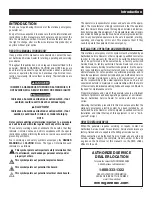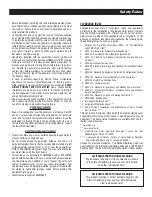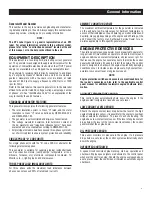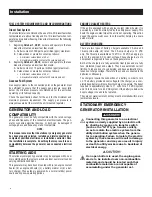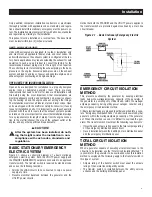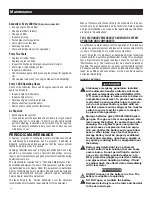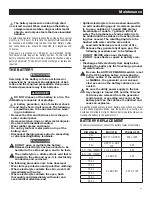
6
OVERCRANK SHUTDOWN
After a prespecified duration of cranking, this function ends the
cranking if the engine has failed to start. The default settings are:
the unit will attempt to start (crank) three (3) times. Each crank
cycle lasts either 10 or 15 seconds, followed by a five (5) second
rest (to cool the starter). After three (3) crank attempts the unit
will shutdown.
RPM SENSOR LOSS SHUTDOWN
If the speed signal to the control panel is lost, engine shutdown
will occur.
DC FUSES
These fuses are located inside the front panel of the control sys-
tem. They protect the panel wiring and components from damag-
ing overload. Refer to the applicable control panel manual for the
location of the fuses.
FUEL SYSTEM
DIESEL FUEL SYSTEM
Diesel fuel is supplied to the generator set from a base-mounted
fuel tank or external source.
Diesel fuels are less volatile than gaseous fuels, however, careless
installation can lead to safety hazards and/or serious problems
with engine/generator performance and reliability.
NOTE:
Appropriate care should be taken in applications where
extremely low ambient temperatures are possible to ensure the
temperature of the diesel fuel is not allowed to fall below levels
where “gelling” could occur.
NATURAL GAS FUEL SYSTEM
Natural gas is supplied in its vapor state. In most cases, the gas
distribution company provides piping from the main gas distribu-
tion line to the standby generator site. The following information
applies to natural gas fuel systems.
• Gas pressure in a building is usually regulated by national, state
and local codes.
• To reduce gas pressure to a safe level before the gas enters a
building, a primary regulator is needed. The natural gas supplier
may or may not supply such a regulator.
• It is the responsibility of the gas supplier to make sure sufficient
gas pressure is available to operate the primary regulator.
• Gas pressure should be measured at the inlet of the unit
mounted regulator. This pressure should never be above the
maximum recommended pressure for the unit. Gas supply vol-
ume to the connection point on the generator must be sufficient
to ensure that the supply gas pressure never falls below the
minimum pressure recommended for the unit when operating
at its full load capacity. Check the specification sheet for the unit
for the minimum pressure requirement.
LP FUEL SYSTEM
LP is supplied as a liquid in pressure tanks. It is usually made up
of propane, butane, or a mixture of the two gases. Propane tends
to vaporize readily even at temperatures as low as -20° F (-29° C).
However, butane reverts to its liquid state when temperatures drop
below 32° F (0° C).
LP in a liquid withdrawal system must be converted to its gaseous
state before it is introduced into the engine carburetor. A vaporizer
converter is generally used to accomplish this. In such a converter,
heated engine coolant is ported through the converter to provide
the necessary heat for conversion of the fuel from a liquid to a
gaseous state.
NOTE:
On units with LP gas liquid withdrawal fuel systems, a block
heater is included as standard equipment. The heater is
powered by the UTILITY power source during non-operating
periods. Thus, heated coolant is always available to aid the fuel
vaporization process.
PROPANE VAPOR WITHDRAWAL FUEL SYSTEM
This type of system utilizes the vapors formed above the liquid
fuel in the supply tank. Approximately 10 to 20 percent of the tank
capacity is needed for fuel expansion from the liquid to the vapor
state. The vapor withdrawal system is generally best suited for
smaller engines that require less fuel. The installer should be aware
of the following:
• Gas pressure requirements for an LP-Gas system at the con-
nection point on the generator set are the same as those for
Natural Gas and are listed in the specification sheet for the unit.
• When ambient temperatures are low and engine fuel consump-
tion is high, the vapor withdrawal system may not function
efficiently.
• Ambient temperatures around the supply tank must be high
enough to sustain adequate vaporization, or the system will not
deliver the needed fuel volume.
• In addition to the cooling effects of ambient air, the vaporization
process itself provides an additional cooling effect which could
adversely effect the fuel supply.
COMBINATION LP/NATURAL GAS FUEL SYSTEM
In some areas, the cost of natural gas may be reduced consider-
ably by procuring the gas on “interrupted service” rates. Such
rates may be obtained by using LP gas as an emergency fuel
when natural gas is not available. Automatic changeover is accom-
plished by using two regulators, either controlled by the control
system or controlled by pressure. Changeover is automatic with
the engine operating.
General Information
Summary of Contents for SD050
Page 18: ...16 16 Notes...
Page 25: ...Notes...
Page 26: ......
Page 28: ......
Page 29: ......
Page 30: ......
Page 34: ......
Page 36: ......
Page 38: ......
Page 40: ......
Page 43: ......
Page 44: ......
Page 46: ......
Page 48: ......
Page 50: ......
Page 52: ......
Page 54: ......
Page 56: ......
Page 58: ......
Page 60: ......
Page 62: ......
Page 64: ......
Page 66: ......
Page 68: ......
Page 69: ......
Page 70: ......
Page 71: ......
Page 72: ......
Page 73: ......
Page 74: ......
Page 75: ......
Page 76: ......
Page 77: ......
Page 78: ......
Page 79: ......
Page 80: ......
Page 81: ......
Page 82: ......
Page 83: ......
Page 84: ......
Page 85: ......
Page 86: ......
Page 87: ......
Page 88: ......
Page 89: ......
Page 90: ......
Page 91: ......
Page 92: ......
Page 93: ......
Page 94: ......
Page 95: ......
Page 96: ......
Page 98: ......
Page 100: ......
Page 102: ......
Page 104: ......
Page 106: ......
Page 108: ...Notes...
Page 109: ...Notes...
Page 110: ...Notes...
Page 111: ......
Page 112: ...GENERAC POWER SYSTEMS INC 211 MURPHY DR P O BOX 310 EAGLE WI 53119 Part No 0J9129 Rev A 04 12...



